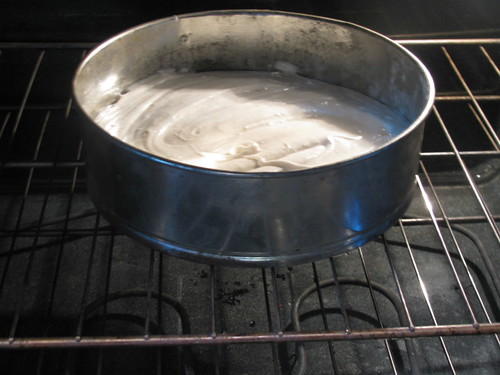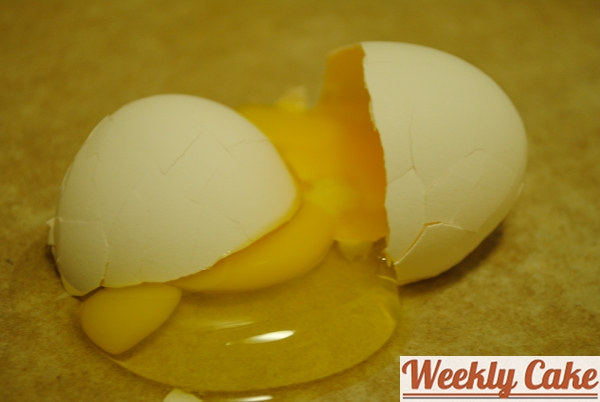 The topic of cracking eggs recently came to mind when I knocked an egg on the floor and decided to take the opportunity to photograph it. Then on the recent finale of TLC’s Next Great Baker, Buddy posed an interesting challenge to the contestants. They had to crack as many eggs as possible (no shells!) in one minute. And during the demonstration, Buddy himself was using the side of the container to crack the eggs. (more…)
The topic of cracking eggs recently came to mind when I knocked an egg on the floor and decided to take the opportunity to photograph it. Then on the recent finale of TLC’s Next Great Baker, Buddy posed an interesting challenge to the contestants. They had to crack as many eggs as possible (no shells!) in one minute. And during the demonstration, Buddy himself was using the side of the container to crack the eggs. (more…)
‘Tips’ Category
-
How to Crack an Egg
February 3, 2012 by Nina Spezzaferro
Category Tips | Tags: cake boss,egg,how to,tips | 1 Comment
-
Recognize Interchangeable Ingredients
December 31, 2011 by Nina Spezzaferro
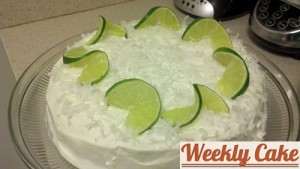 You’ve heard the phrase, “Baking is a science;” it’s true. Just know that baking soda and baking powder are not the same thing. You can make any recipe your own by tweaking certain ingredients to your taste, so long as you maintain certain wet to dry ratios and observe measurements.
You’ve heard the phrase, “Baking is a science;” it’s true. Just know that baking soda and baking powder are not the same thing. You can make any recipe your own by tweaking certain ingredients to your taste, so long as you maintain certain wet to dry ratios and observe measurements.Does a recipe call for vanilla extract? Try almond extract or coconut extract if you think those flavors will work. If a recipe calls for liqueur, use one you have on hand if it will complement the recipe. Substitute one chopped nut for another. Eliminate raisins if you hate them. You can easily create your own signature desserts by using recipes as your scientific formula and your taste buds as your guide.
Category Tips | Tags: tips | 1 Comment
-
Check For Doneness
December 31, 2011 by Nina Spezzaferro
While recipes are the best guide you have to determine how long something needs to bake for, there are many variables to consider, such as altitude, humidity, oven size, and so on. If your recipe was discovered online, you might consider perusing the recipe comments and reviews to see if anyone’s commented on the bake time.
A few minutes before the recipe is supposed to be finished baking, check on it. A lot of bakers use the toothpick trick – inserting a toothpick into the center of the cake to see if it comes out clean. Or you could try the finger method by pressing a clean finger in the center of the cake to see if it springs back (it’s done!) or sinks in (let it bake a few more minutes). In other words, your baked goods need supervision because a burned cake just can’t be saved.
Category Tips | Tags: tips,toothpick test | 1 Comment
-
Rotate Your Pans
December 31, 2011 by Nina Spezzaferro
This is another tip, courtesy of my mom. Just as ovens often don’t have an accurate temperature dial, they have a tendency to bake unevenly.
Rotating your pan 180 degrees midway through the baking process will help ensure your confections bake evenly.
The February 2011 issue of Reader’s Digest suggests lining a cookie sheet with a layer of white bread slices and baking them under the broiler to determine where your oven is the hottest. From there you can better figure out how to rotate your pans for more even baking. For the full how-to, check out 3 Shortcuts From All Over.
(Thanks to Dad, who passed along the Reader’s Digest article.)
Category Tips | Tags: cake pans,tips | 8 Comments
-
Get an Oven Thermometer
December 31, 2011 by Nina Spezzaferro
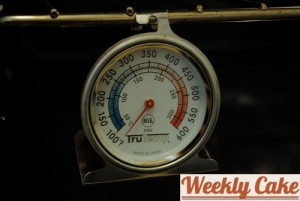 I discovered this gem after baking at a few different friends’ homes. Since my mom is into baking, I grew up in a home that had a thermometer in the oven. So I assumed all ovens came with them. I’m not talking about the temperature dial on the outside, either. I’m talking about a round thermometer that hangs from the rack inside the oven.
I discovered this gem after baking at a few different friends’ homes. Since my mom is into baking, I grew up in a home that had a thermometer in the oven. So I assumed all ovens came with them. I’m not talking about the temperature dial on the outside, either. I’m talking about a round thermometer that hangs from the rack inside the oven.You might tell your oven to go to 350 degrees. But you know what? Your oven’s a liar and so is mine. An internal oven thermometer allows you to gauge how much your oven lies so you can adjust the temperature dial accordingly and ensure your baked goods are being baked at the proper temperature. It will also allow you to know when the oven’s finished pre-heating and will save you the grief of burned cookies or soupy cakes. And they only cost a few bucks.
I would love to know, how much does your oven lie? Mine lies up to 50 degrees, so when pre-heating to 350, I set the dial to 400. Once you get a grasp on how inaccurate the dial is, you can yank it off, depending on your oven model, and readjust it accordingly. Those with digital oven dials (like me!) are out of luck on this step, which is why oven thermometers are crucial when baking.
Category Tips | Tags: thermometer,tips | 3 Comments
-
How to Sift
December 31, 2011 by Nina Spezzaferro
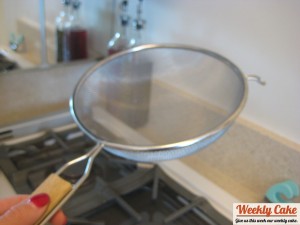 Some recipes call for ingredients to be measured, then sifted. Others call for ingredients to be sifted, then measured. And most recipes call for all dry ingredients to be sifted together. I sift every cake recipe’s dry ingredients, even if it’s just the boxed cake mix. I’d sift my morning coffee grounds if I had the time.
Some recipes call for ingredients to be measured, then sifted. Others call for ingredients to be sifted, then measured. And most recipes call for all dry ingredients to be sifted together. I sift every cake recipe’s dry ingredients, even if it’s just the boxed cake mix. I’d sift my morning coffee grounds if I had the time.What is sifting? It’s the act of passing dry ingredients through a fine grate to aerate and weed out clumps, resulting in light, airy cakes.
You don’t have to invest in a fancy sifter either. The metal, hand crank style sifters tend to get rusty and are a pain to keep clean, which is why I prefer a simple strainer for sifting, pictured at left. You can also find plastic versions that work just as well at 99 cent stores and they’re dishwasher safe. They also come in handy for dusting finished desserts with powdered sugar or cocoa. Just place the dry ingredients in the strainer a little at a time and either shake the strainer back and forth or gently rub the dry ingredients against the strainer with your hand.
Finally, be sure to heed any directions regarding sifting pre or post-measurement. I once made a cream cheese frosting recipe that called for four cups of sifted confectioners sugar with four unsifted cups. I’m lucky it didn’t induce any diabetic comas.
Category Tips | Tags: sifting,tips | 10 Comments

